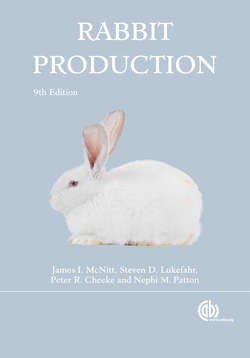Читать книгу Rabbit Production - James I McNitt - Страница 67
На сайте Литреса книга снята с продажи.
Fur Chewing
ОглавлениеWhen there are several rabbits in a cage and the habit of fur chewing develops, the eyelashes and whiskers are chewed first, then the fur on the head and on the body. Rabbits that are alone in a cage chew the fur on their sides or back of their rumps and are capable of reaching fur on the sides of their body where it would seem impossible. If rabbits can reach the coat of another rabbit in an adjoining cage, they may chew its fur. Sometimes does chew the fur on their own young. In cases in which rabbits are chewing their own fur or the fur of other rabbits, the coats have an uneven appearance (Fig. 5.17).
Fig. 5.17. Examples of fur chewing. The dark patches are areas of exposed skin. These rabbits were fed a diet containing sunflower leaves, which contain tannins that react with protein to cause a protein deficiency. (Courtesy of OSU Rabbit Research Center)
Fur chewing is most likely due to a faulty ration or to the rabbits not receiving the proper amount of feed and is usually associated with a ration that does not contain enough fiber. Keeping good quality hay or straw available at all times and feeding small quantities of green feed daily will assist materially in preventing the fur chewing habit from developing. If the feeding of hay does not solve the problem, increasing the protein content of the ration might help. The addition of 2½ kg of magnesium oxide per ton of feed sometimes aids in control of fur chewing.
Occasionally rabbits will pull fur from their cage mates because of boredom. This vice is overcome by putting a round can or a wooden block in the cage. The rabbits spend hours chewing and playing with these objects and seem to forget about the fur chewing. Hanging a small block of wood in the cage will also work and will also provide the additional benefit of reducing fighting. This method of prevention does not work if there is a dietary deficiency.
